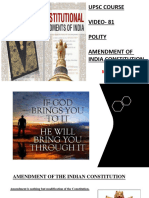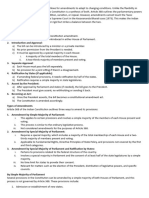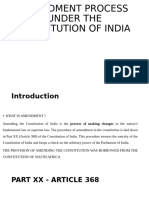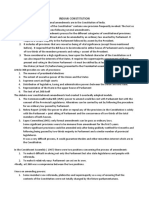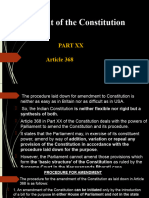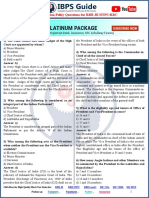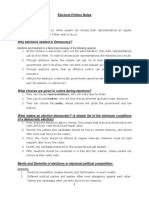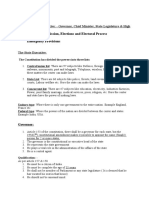Module 5
Uploaded by
Utkarsh GuptaModule 5
Uploaded by
Utkarsh GuptaSession 9: Amendments to the Constitution and
Election Commission of India
Contents
Amendments to the Constitution ............................................................................................... 2
Types of majorities .................................................................................................................... 2
Amendments .............................................................................................................................. 2
Types of Amendments ........................................................................................................... 2
Procedure of Amendment ...................................................................................................... 3
Amendments by simple majority ........................................................................................... 3
7th Amendment 1956 .............................................................................................................. 3
9th Amendment 1960 .............................................................................................................. 3
10th Amendment..................................................................................................................... 3
12th Amendment 1962 ............................................................................................................ 4
42nd amendment 1976 ............................................................................................................ 4
44th Amendment 1978 ............................................................................................................ 4
61st Amendment 1989 ............................................................................................................ 4
73rd Amendment 1992............................................................................................................ 4
74th Amendment 1992 ............................................................................................................ 4
75th Amendment 1994 ............................................................................................................ 5
86th Amendment – 2002 ......................................................................................................... 5
91st Amendment 2003 ............................................................................................................ 5
94th Amendment 2006 ............................................................................................................ 5
95th Amendment 2009 ............................................................................................................ 5
100th Amendment 2015 .......................................................................................................... 6
101st Amendment 2016 .......................................................................................................... 6
118th Amendment 2012 .......................................................................................................... 6
126th Amendment................................................................................................................... 6
Election commission of India .................................................................................................... 7
Election Commissioners ........................................................................................................ 7
Independence of Election Commission ................................................................................. 7
Powers and Functions of Election commission ......................................................................... 7
Constitution of India Dr. Abdul Khader A A Page: 1 of 8
Amendments to the Constitution
• Article 368 of the Constitution deals with the power of parliament to amend the
constitution and its procedures.
• It states that the Parliament may amend the Constitution by way of addition, variation,
or repeal of any provision in accordance with the procedure laid down for the purpose.
• However, the Parliament cannot amend those provisions which form the ‘basic
structure’ of the Constitution. This was ruled by the Supreme Court in
the Kesavananda Bharati case (1973)
Types of majorities
1. Simple Majority: 50% of the members present and voting (Used for passing of
regular bills)
2. Absolute Majority: More than 50% of Total membership of the house. When the
total membership of the Lok Sabha is 545, the Absolute majority is 273 (Used for the
formation of Government after General Election)
3. Effective majority: More than 50% of the effective strength of the house. If the
total strength of house is 245 and 45 vacancies. The effective strength is 200. The
effective majority is 101 (Used for removal of Vice President in Rajya Sabha, removal
of speaker and deputy speaker in Lok Sabha)
4. Special Majority (Article 249): 2/3rd of the members present and voting (To pass
Rajya Sabha resolution to empower parliament to make laws in state list)
5. Special Majority (Article 368): 2/3rd Members present and voting supported by more
than 50% of total strength of the house (To make constitutional amendments and
impeachment)
Amendments
Types of Amendments
There are two types of amendments.
1. Amendment is by a special majority of the Parliament (Lok Sabha & Rajya Sabha)
2. Amendment by a special majority of the Parliament with the ratification by half of
the total states (Involving Federal structure)
The constituents of basic structure are not clearly defined by the court. However, it has been
interpreted to provisions like values enshrined in preamble like secularism, equality,
federalism, separation of power, independence judiciary, rule of law etc.
Constitution of India Dr. Abdul Khader A A Page: 2 of 8
Procedure of Amendment
• An amendment of the Constitution may be initiated by the introduction of a Bill for
the purpose.
• The initiation can be in either house of the Parliament.
• The amendment has to be passed by each house with a special majority as per Article
368.
• If changes to the Federal structure is involved, it is to be Ratified by NOT less than
half the number of states.
• Then, it is presented to the President for his assent an upon such assent being given to
the bill, the Constitution shall stand amended.
Amendments by simple majority
• There are some other amendments which are NOT considered amendments under
article 368 like
– Establishment of new states
– Abolition and creation of Legislative councils in the states
– Allowances and privileges of President, Governors, Judges, Speaker etc.
– Quorum in parliament
– Citizenship and acquisition and termination
• These amendments can be done with Simple Majority in the parliament.
7th Amendment 1956
• The constitution provides for a high court for each state.
• But the, Seventh Amendment Act of 1956 authorized the Parliament to establish a
common High Court for two or more states and/or union territory.
• Extended the jurisdiction of High courts to Union Territories
• E.g.: States of Punjab and Haryana have a common High court in Chandigarh
9th Amendment 1960
• For solving certain boundary disputes between India and Pakistan as per agreement
signed by Jawaharlal Nehru and Mr. Feroze Khan Noon, Prime Minister of Pakistan
• Facilitated the cession of Indian territory of Berubari Union (located in West
Bengal) to Pakistan as provided in the Indo-Pakistan Agreement (1958).
10th Amendment 1961
• 10th amendment of the Indian Constitution
• Incorporated Dadra and Nagar Haveli as the seventh Union territory of India, by
amending the First Schedule to the Constitution.
Constitution of India Dr. Abdul Khader A A Page: 3 of 8
12th Amendment 1962
• The Twelfth Amendment Act, 1962 incorporated Goa, Daman and Diu in the Indian
Union.
• India acquired the three territories such as Goa, Daman and Diu from the Portuguese
• Later, in 1987, Goa was conferred a statehood. Consequently, Daman and Diu were
made a separate union territory.
42nd amendment 1976
• This amendment is also famous as the mini-Constitution.
• This amendment brought a big change in the Constitution’s preamble by adding the
words ‘SOCIALIST’, ‘SECULAR’, and ‘INTEGRITY’ in the preamble.
• This amendment made it mandatory for the President to work with the aid and advice
of the council of ministers.
This amendment also added a vital Part IVA in the Constitution as Fundamental duties
44th Amendment 1978
• After this amendment, the right to property no more remained a Fundamental right
in Part III of the Constitution.
• Now the right to property is only a legal and right under Article 300A.
61st Amendment 1989
• This amendment brought a change in the pattern of the election in India.
• It reduced the voting age from 21 to 18 years.
73rd Amendment 1992
• Granted constitutional status and protection to the panchayat raj institutions.
• For this purpose, the Amendment has added a new Part-IX entitled as ‘the Panchayats’
and a new Schedule XI containing 29 functional items of the panchayats.
74th Amendment 1992
• Granted constitutional status and protection to the urban local bodies.
• For this purpose, the Amendment has added a new Part IX-A entitled as ‘the
municipalities and a new Schedule XII containing 18 functional items of the
municipalities.
Constitution of India Dr. Abdul Khader A A Page: 4 of 8
75th Amendment 1994
• Provided for the establishment of rent tribunals for the adjudication of disputes with
respect to rent, its regulation and control and tenancy issues including the rights, title
and interest of landlords and tenants.
86th Amendment – 2002
• Made elementary education a fundamental right.
• The newly added Article 21-A declares that “the State shall provide free and
compulsory education to all children of the age of six to fourteen years in such
manner as the State may determine”.
• Changed the subject matter of Article 45 in Directive Principles. It now reads—“The
State shall endeavor to provide early childhood care and education for all children
until they complete the age of 14 years”.
• Added a new fundamental duty under Article 51-A which reads— “It shall be the
duty of every citizen of India who is a parent or guardian to provide opportunities for
education to his child or ward between the age of six and fourteen years”
91st Amendment 2003
• The total number of ministers, including the Prime Minister, in the Central Council
of Ministers shall not exceed 15% of the total strength of the Lok Sabha (Article
75(1A)).
• The total number of ministers, including the Chief Minister, in the Council of
Ministers in a state shall not exceed 15% of the total strength of the legislative
Assembly of that state. But, the number of ministers, including the Chief Minister, in
a state shall not be less than 12 (Article 164(1A)).
• The provision of the Tenth Schedule (anti-defection law) pertaining to exemption from
disqualification in case of split by one-third members of legislature party has been
deleted.
• It means that the defectors have no more protection on grounds of splits.
94th Amendment 2006
• Freed Bihar from the obligation of having a tribal welfare minister and extended the
same provision to Jharkhand and Chhattisgarh.
• This provision will now be applicable to the two newly formed states and Madhya
Pradesh and Orissa, where it has already been in force (Article 164(1))
95th Amendment 2009
• Extended the reservation of seats for the SCs and STs and special representation for
the Anglo-Indians in the Lok Sabha and the state legislative assemblies for a further
period of ten years i.e., up to 2020 (Article 334).
Constitution of India Dr. Abdul Khader A A Page: 5 of 8
100th Amendment 2015
• This amendment is Land Boundary Agreement (LBA) between India and Bangladesh
101st Amendment 2016
• Goods and Services Tax (GST) commenced with the enactment of the 101st
Constitution Amendment Act, 2016 on 8th September 2016 and the subsequent
notifications.
• Articles 246A, 269A and 279A were added to the constitution. The amendment made
changes in the 7th schedule of the constitution.
118th Amendment 2012
• Lok Sabha approved the Constitution (118th Amendment) Bill, 2012 which seeks to
provide special status to six backward districts in the Hyderabad Karnataka region, with
provision for reservation in education and jobs for local people.
• The Bill introduces a new Article 371-J to provide special recognition for the six
backward districts in north Karnataka: Gulbarga, Yadgir, Raichur, Bidar, Koppal
and Bellary.
• The Bill provides for the creation of a separate development board and equitable
allocation of funds for the development of the region.
• In addition to this, it will provide quota in public employment through establishment
of local cadres and reservation in education and vocational training institutions for
those who belong to the region by birth or domicile.
126th Amendment
• The Bill extended the reservation for SCs and STs in the Lok Sabha and State
assemblies,
• It was due to end on January 25, 2020, now extended for a period of 10 years, the
seventh such 10-year extension given since the Constitution was enacted in 1950.
• However, the Bill also ended the provision for nomination of Anglo-Indians to the
Lok Sabha and Assemblies “seventy years from the commencement of this
Constitution”, that is January 2020
Constitution of India Dr. Abdul Khader A A Page: 6 of 8
Election commission of India
• India is a democratic country. Elections are part of the democratic process. In order
to conduct free and fair elections, an independent body named the Election
Commission has been constituted.
• It is headed by the chief election commissioner and consists of two election
commissioners. The election commissioners are appointed by the president and can
be removed by the same procedure as that in case of supreme court judges.
Election Commissioners
• Up to 1989, Election commission was a single member body. (Only Chief Election
Commissioner)
• In 1989, two more election commissioners were appointed and ECI became a multi
member body (Consisting of 3 election commissioners including Chief Election
Commissioner)
• The chief and the two other election commissioners have the same emoluments
including salaries, which are the same as a Supreme Court judge.
• In case of a difference of opinion amongst the Chief Election Commissioner and/or two
other election commissioners, the matter is decided by the Commission by a majority.
• The office is held by them for a term of 6 years or until they attain 65 years, whichever
happens first.
• They can also be removed or can resign at any time before the expiry of their term.
Independence of Election Commission
• The chief election commissioner is provided with security of tenure.
• He cannot be removed from his office except in the same manner and on the same
grounds as a judge of the Supreme Court. (Impeachment for proven misbehavior)
• Does NOT hold his office until the pleasure of the president, though he is appointed
by him.
• The service conditions of the chief election commissioner cannot be varied to his
disadvantage after his appointment.
• Any other election commissioner or a regional commissioner cannot be removed
from office except on the recommendation of the chief election commissioner.
Powers and Functions of Election commission
• Preparation of electoral rolls
• Revision of electoral rolls
• Determination of population for the purpose of elections
• Election of the president and vice-president
Constitution of India Dr. Abdul Khader A A Page: 7 of 8
• Superintendence, direction and conduct of all elections to Parliament and state
legislatures.
• Deciding the qualifications for the members of Parliament
• Deciding on the composition of the state legislatures
• Deciding the matters relating to reservation of seats to Scheduled Castes (SCs) and STs
• Ensure an equal chance in participating in the election process to all political parties.
• Enforce strict observation of model code of conduct during elections.
• Advising the President on matters concerning the disqualification of MPs.
• Registering political parties and granting them the status of national or state parties
(depending on their poll performance).
• Granting recognition to the various political parties and allocating them election
symbols
• Cancelling polls in case of booth capturing, rigging, violence and other irregularities
• Appointing officers for inquiring into disputes concerning electoral arrangements.
• Notifying the schedules and dates of elections and scrutinizing nomination papers
• Determining the model code of conduct to be followed by the political parties and
candidates during elections.
Constitution of India Dr. Abdul Khader A A Page: 8 of 8
Session 8: State Legislature and Executive
Contents
Federal system ........................................................................................................................... 2
Three lists under Schedule VII – Article 246 ............................................................................ 2
Examples of important subjects in 3 lists .............................................................................. 2
42nd Amendment 1976 ............................................................................................................... 3
69th Amendment 1991 ................................................................................................................ 3
State Legislature......................................................................................................................... 3
Legislative Assembly or Vidhana Sabha ................................................................................... 4
Presiding officer of Vidhana Sabha – Speaker ...................................................................... 4
Powers and functions of Legislative Assembly ......................................................................... 4
Legislative Function: ............................................................................................................. 4
Financial function .................................................................................................................. 4
Administrative Function ........................................................................................................ 4
Electoral function ................................................................................................................... 5
Legislative Council or Vidhana Parishad .................................................................................. 5
Presiding officer of Vidhana Parishad ................................................................................... 5
State Executive........................................................................................................................... 5
The Governor ............................................................................................................................. 5
Eligibility to become a Governor. .......................................................................................... 6
Powers and functions of a Governor .......................................................................................... 6
Executive Powers ................................................................................................................... 6
Legislative powers ................................................................................................................. 6
Financial powers .................................................................................................................... 6
Judicial Powers ...................................................................................................................... 6
Discretionary Powers ............................................................................................................. 6
The Chief Minister ..................................................................................................................... 7
Powers and functions of the Chief Minister .............................................................................. 7
The Council of Ministers ........................................................................................................... 7
Local Self Government .............................................................................................................. 8
Need for local self-government. ............................................................................................ 8
Functions of local self-governments ...................................................................................... 8
Financial Sources of local self-governments ......................................................................... 8
Constitution of India Dr. Abdul Khader A A Page: 1 of 8
Federal system
• A federal system of government is one in which the different states or provinces of
the country have important powers to make their own laws and decisions.
• the Indian Constitution in Article 1 describes the country as ‘Union of States’ although
its Constitution is federal in nature.
• According to Dr B R Ambedkar, the phrase ‘Union of States’ has been preferred to
‘Federation of States’ for two following reasons:
• The Indian federation is not the result of an agreement among the states, like the
American Federation.
• The states have no right to secede from the federation.
• Federalism is part of the basic structure of the Indian constitution which cannot be
altered or destroyed through constitutional amendments.
Three lists under Schedule VII – Article 246
Examples of important subjects in 3 lists
Union List State List Concurrent List
• Defense • Public order • Education
• Army • Police • Forest
• International Relations • Public health and • Trade unions
• Ports sanitation • Marriage
• Railways • Hospitals and dispensaries • Adoption
• Highways • Betting and gambling
• Succession
• Communication
Total
Total Total
Originally – 47 items
Originally – 9 subjects Originally – 66 subjects
Now – 52 items
Now – 100 subjects Now – 61 subjects
Constitution of India Dr. Abdul Khader A A Page: 2 of 8
42nd Amendment 1976
42nd amendment Act 1976 shifted below mentioned five subjects from State list to Concurrent
List:
1. Education
2. Forests
3. Protection of wild animals and birds
4. Weights and measures and
5. Administration of justice, constitution and organization of all courts except the
Supreme Court and the High Courts
69th Amendment 1991
The 69th Constitutional Amendment Act of 1991 made special provision in relation to National
Capital.
Laws cannot be made by Delhi government on three subjects under State List named as
1. Public Order,
2. Police &
3. Land
State Legislature
• The state legislature consists of the governor, chief minister and council of ministers.
• A state can either have a unicameral or a bicameral legislature.
• In a bicameral legislature, there are two Houses known as the Legislative Assembly
(Vidhan Sabha) and Legislative Council (Vidhan Parishad)
• Andhra Pradesh, Karnataka, (Jammu and Kashmir – before conversion to UT), Uttar
Pradesh, Telangana, Bihar and Maharashtra have bicameral legislatures while the
rest of the states have unicameral legislature.
Constitution of India Dr. Abdul Khader A A Page: 3 of 8
Legislative Assembly or Vidhana Sabha
• Members: Members of the legislative assembly (MLAs) are elected through a system
of universal adult franchise.
• All citizens of India who has attained the age of 25 and does not hold an office of
profit are eligible to contest an election.
• Usually, the number of members in an assembly should not exceed 600.
• The size of an assembly is determined by the population of the state.
• Members are elected for a term of 5 years.
Presiding officer of Vidhana Sabha – Speaker
• The speaker of the assembly is the presiding officer of the house.
• S/he is elected by the members of the assembly for a period of five years.
• The speaker of a legislative assembly plays a role that is similar to the Speaker of the
Lok Sabha.
• The deputy speaker is also elected by members of the assembly. S/he conducts the
sittings in the absence of the speaker.
Powers and functions of Legislative Assembly
Legislative Function:
• The assembly has the power to make laws on state subjects, like police, health, local
governance etc.
• The assembly can pass the bill and send it to governor for his consent.
• The Governor can reserve the bill for the consideration of the president
Financial function
• The state budget is introduced in the legislative assembly.
• When compared with the legislative council, the assembly has far greater authority
over money Bills.
• The Legislative council cannot reject any finance Bill, but can postpone it for a
maximum period of 14 days.
Administrative Function
• The state legislature controls the administration of the state.
• The executive body of the state functions as long as it enjoys the confidence of the
assembly.
• The council of ministers is responsible to the assembly.
Constitution of India Dr. Abdul Khader A A Page: 4 of 8
Electoral function
The legislative assembly takes part in electing the following.
1. The members of the legislative council,
2. The Rajya Sabha and also
3. The president of India
Legislative Council or Vidhana Parishad
• Members: The legislative council is partly elected and partly nominated body.
• One-third of the members of the legislative council are elected from the legislative
assembly.
• one-third from local bodies such as municipalities and district boards
• one-twelfth from the graduate constituency,
• one-twelfth teacher’s constituency and
• one-sixth are nominated by the governor from the fields of literature, sports, science,
arts, social service, etc.
• The minimum eligible age for becoming a member of the council is 30 years.
• Nominated members do not have voting rights.
• The total membership of the House should not be more than one-third of the total
membership of the legislative assembly and should not be less than 40 members.
Presiding officer of Vidhana Parishad
• The chairperson presides over the meetings of the council.
• S/he is elected by the members. In the absence of the chairperson, the deputy
chairperson conducts the sittings of the House.
State Executive
The Governor
• The governor of a state is appointed by the president of India on the recommendation
of the union council of ministers.
• S/he enjoys a similar position in the state assembly as does the president with respect
to the parliament.
• S/he is the constitutional head of the state.
• S/he exercises power on the advice of the council of ministers of the state.
Constitution of India Dr. Abdul Khader A A Page: 5 of 8
Eligibility to become a Governor.
• To be appointed as the governor of a state,
• one must be a citizen of India and
• not less than 35 years of age.
• The person must not be a member of the Union Parliament or any state legislature.
• The governor of a state can only be removed by the president of India.
Powers and functions of a Governor
Executive Powers
• As an executive head, the governor appoints the chief minister and council of ministers.
• He appoints members of the state public service commission members and other high-
ranking officials on the advice of the council of ministers.
Legislative powers
• The governor has the powers to summon, prorogue and dissolve the House.
• S/he enjoys the power to nominate members to the council and the legislative
assembly.
• A Bill cannot become a law without his consent.
• He can issue ordinances.
• Budget cannot be presented without his consent.
Financial powers
• The state budget is presented with the Governor’s consent.
• The governor appoints members of the state planning and finance commissions.
Judicial Powers
• Appointments, postings and transfers of district judges are made by the governor.
• He has the power to pardon and reduce punishment sentences.
Discretionary Powers
• This power allows the governor the freedom to decide what should be done in a
particular situation without following the advice of his ministers.
• The governor can recommend to the president to dissolve the assembly, proclaim an
emergency, and introduce president's rule in his/her state.
Constitution of India Dr. Abdul Khader A A Page: 6 of 8
The Chief Minister
• The chief minister is the real head of the state.
• S/he is the head of the council of ministers.
• The chief minister is the leader of the majority party of the legislative assembly.
• The state ministers are appointed by the governor on the advice of the chief minister.
• The chief minister forms the government with the support of the ministers.
• The term of office of the chief minister is five years or till the dissolution of the
assembly.
• The chief minister remains in office as long as s/he enjoys the confidence of the House
and has to resign if his/her party loses its majority on the floor of the House.
• The resignation of the chief minister results in the resignation of the entire council
of ministers
Powers and functions of the Chief Minister
• S/he forms the ministry with the support of the ministers and allots portfolios to
ministers.
• S/he can reshuffle his ministry as and when s/he likes and may ask anyone of his
colleagues to resign, can request the governor to dismiss him.
• S/he presides over the Cabinet and takes decisions in formulating policies and
programs.
• S/he supervises and coordinates policies of several ministers and departments.
• The sessions of the House are summoned and prorogued by the governor on the
advice of the chief minister.
• S/he keeps the legislature and the governor informed of all the decisions, policies and
programs of the government.
The Council of Ministers
• S/he forms the ministry with the support of the ministers and allots portfolios to
ministers.
• S/he can reshuffle his ministry as and when s/he likes and may ask anyone of his
colleagues to resign, can request the governor to dismiss him.
• S/he presides over the Cabinet and takes decisions in formulating policies and
programs.
• S/he supervises and coordinates policies of several ministers and departments.
• The sessions of the House are summoned and prorogued by the governor on the
advice of the chief minister.
• S/he keeps the legislature and the governor informed of all the decisions, policies and
programs of the government.
Constitution of India Dr. Abdul Khader A A Page: 7 of 8
Local Self Government
Need for local self-government.
1. India is a vast country with many villages. It is difficult for a central authority to reach
out to villages.
2. India is a democracy too and it seeks to involve the people at the grassroots level in
decision-making.
3. Local governments provide opportunities for people to express their problems and get
those solved at the local level.
Functions of local self-governments
• To plan and undertake the developmental works like providing drinking water,
healthcare facilities, housing, education, electricity and sanitation.
• To provide facilities for the distribution of essential commodities Iike food grains,
kerosene, etc. (PDS)
• To implement the programs of the Central and the state governments in an effective
manner
• To maintain and protect panchayat property.
• To identify the beneficiaries for the welfare schemes
• To plan and undertake welfare schemes for the benefit of SCs, STs, women, children
and other weaker sections.
• To collect taxes and penalties
Financial Sources of local self-governments
• Rent: Local self-governments require huge amounts of money to carry out welfare
programs and projects. They raise funds through taxes on property, buildings, vacant
sites, shops, markets, to name a few.
• Cess: Local governing bodies collect education cess, health cess, water cess and
reading room cess from local people.
• Grant: Financial grants provided by the state and Central governments add to their
source of revenue.
Constitution of India Dr. Abdul Khader A A Page: 8 of 8
You might also like
- Unit 1 Amendment & Historical PerspectivesNo ratings yetUnit 1 Amendment & Historical Perspectives4 pages
- Article 368 of The Indian Constitution Mentions Two Types of Amendments To The Indian ConstitutionNo ratings yetArticle 368 of The Indian Constitution Mentions Two Types of Amendments To The Indian Constitution4 pages
- Constitution - Amendment of The ConstitutionNo ratings yetConstitution - Amendment of The Constitution5 pages
- Amendmend Process Under The Constitution of India Teaching Practice FinalNo ratings yetAmendmend Process Under The Constitution of India Teaching Practice Final39 pages
- Polity 12 Amendment To Consti Tutu I OnNo ratings yetPolity 12 Amendment To Consti Tutu I On32 pages
- Procedure of Amendment of The ConstitutionNo ratings yetProcedure of Amendment of The Constitution3 pages
- Major Constitutional Amendment - 1 - 19374877 - 2023 - 11 - 28 - 11 - 04No ratings yetMajor Constitutional Amendment - 1 - 19374877 - 2023 - 11 - 28 - 11 - 044 pages
- 1736320297-FF2025_POLITY-3_MAJOR-AMENDMENTS-TO-THE_250214_225517No ratings yet1736320297-FF2025_POLITY-3_MAJOR-AMENDMENTS-TO-THE_250214_22551720 pages
- Amendment of The Constituion, Basic StructureNo ratings yetAmendment of The Constituion, Basic Structure16 pages
- Amendment of The Constitution - Meaning, Types, Procedure & LimitationsNo ratings yetAmendment of The Constitution - Meaning, Types, Procedure & Limitations8 pages
- GS Score - MAJOR - AMENDMENTS - TO - THE - CONSTITUTIONNo ratings yetGS Score - MAJOR - AMENDMENTS - TO - THE - CONSTITUTION20 pages
- Important Constitutional Amedments and Articles Mains Marks Booster100% (1)Important Constitutional Amedments and Articles Mains Marks Booster44 pages
- Kalyan Sir - Amendment of The Indian Constitution PDFNo ratings yetKalyan Sir - Amendment of The Indian Constitution PDF8 pages
- List of Amendments of The Constitution of India Via Pawan SirNo ratings yetList of Amendments of The Constitution of India Via Pawan Sir13 pages
- Amendment of The Constitution & Basic Structure: By: Kartikey ChaudharyNo ratings yetAmendment of The Constitution & Basic Structure: By: Kartikey Chaudhary16 pages
- List of Amendments of The Constitution of IndiaNo ratings yetList of Amendments of The Constitution of India13 pages
- List of Amendments of The Constitution of India - WikipediaNo ratings yetList of Amendments of The Constitution of India - Wikipedia67 pages
- Article 368 of The Constitution of India Provides For The Procedure of Amending The ConstitutionNo ratings yetArticle 368 of The Constitution of India Provides For The Procedure of Amending The Constitution5 pages
- KALYAN SIR_ AMENDMENT OF THE INDIAN CONSTITUTIONNo ratings yetKALYAN SIR_ AMENDMENT OF THE INDIAN CONSTITUTION8 pages
- 07 March Group-2 Test-05 Key & ExplanationNo ratings yet07 March Group-2 Test-05 Key & Explanation36 pages
- Constitutions Amendment - 7a1dc98c Ed4f 4f03 8a66 91c95f9c1944No ratings yetConstitutions Amendment - 7a1dc98c Ed4f 4f03 8a66 91c95f9c194410 pages
- Types of Amendments in Indian Constitution Indian Polity NotesNo ratings yetTypes of Amendments in Indian Constitution Indian Polity Notes2 pages
- Important Questions For CBSE Class 7 Social Science - Social and Political Life Chapter 3 - How The State Government WorksNo ratings yetImportant Questions For CBSE Class 7 Social Science - Social and Political Life Chapter 3 - How The State Government Works6 pages
- 7th Social-Political Sciences-Social and Political Life-2 PDFNo ratings yet7th Social-Political Sciences-Social and Political Life-2 PDF115 pages
- Summary and Conclusions: Chapter - ViiiNo ratings yetSummary and Conclusions: Chapter - Viii11 pages
- Building Connections Political Corruption and Road Construction in India PDFNo ratings yetBuilding Connections Political Corruption and Road Construction in India PDF17 pages
- Anti - Defection Law Dated 01st September 2022No ratings yetAnti - Defection Law Dated 01st September 20224 pages
- List of Questions Asked in Personal InterviewNo ratings yetList of Questions Asked in Personal Interview8 pages
- Case Based MCQS: Cbse Term Ii Political Science Class 11ThNo ratings yetCase Based MCQS: Cbse Term Ii Political Science Class 11Th1 page
- TNPSC SURESH IAS ACADEMY Suresh 360 August 2022100% (2)TNPSC SURESH IAS ACADEMY Suresh 360 August 2022126 pages
- Facts of The Case Are As Follows:: Moot ProblemNo ratings yetFacts of The Case Are As Follows:: Moot Problem3 pages
- Article 368 of The Indian Constitution Mentions Two Types of Amendments To The Indian ConstitutionArticle 368 of The Indian Constitution Mentions Two Types of Amendments To The Indian Constitution
- Amendmend Process Under The Constitution of India Teaching Practice FinalAmendmend Process Under The Constitution of India Teaching Practice Final
- Major Constitutional Amendment - 1 - 19374877 - 2023 - 11 - 28 - 11 - 04Major Constitutional Amendment - 1 - 19374877 - 2023 - 11 - 28 - 11 - 04
- 1736320297-FF2025_POLITY-3_MAJOR-AMENDMENTS-TO-THE_250214_2255171736320297-FF2025_POLITY-3_MAJOR-AMENDMENTS-TO-THE_250214_225517
- Amendment of The Constitution - Meaning, Types, Procedure & LimitationsAmendment of The Constitution - Meaning, Types, Procedure & Limitations
- GS Score - MAJOR - AMENDMENTS - TO - THE - CONSTITUTIONGS Score - MAJOR - AMENDMENTS - TO - THE - CONSTITUTION
- Important Constitutional Amedments and Articles Mains Marks BoosterImportant Constitutional Amedments and Articles Mains Marks Booster
- Kalyan Sir - Amendment of The Indian Constitution PDFKalyan Sir - Amendment of The Indian Constitution PDF
- List of Amendments of The Constitution of India Via Pawan SirList of Amendments of The Constitution of India Via Pawan Sir
- Amendment of The Constitution & Basic Structure: By: Kartikey ChaudharyAmendment of The Constitution & Basic Structure: By: Kartikey Chaudhary
- List of Amendments of The Constitution of India - WikipediaList of Amendments of The Constitution of India - Wikipedia
- Article 368 of The Constitution of India Provides For The Procedure of Amending The ConstitutionArticle 368 of The Constitution of India Provides For The Procedure of Amending The Constitution
- Constitutions Amendment - 7a1dc98c Ed4f 4f03 8a66 91c95f9c1944Constitutions Amendment - 7a1dc98c Ed4f 4f03 8a66 91c95f9c1944
- Types of Amendments in Indian Constitution Indian Polity NotesTypes of Amendments in Indian Constitution Indian Polity Notes
- Important Questions For CBSE Class 7 Social Science - Social and Political Life Chapter 3 - How The State Government WorksImportant Questions For CBSE Class 7 Social Science - Social and Political Life Chapter 3 - How The State Government Works
- 7th Social-Political Sciences-Social and Political Life-2 PDF7th Social-Political Sciences-Social and Political Life-2 PDF
- Building Connections Political Corruption and Road Construction in India PDFBuilding Connections Political Corruption and Road Construction in India PDF
- Case Based MCQS: Cbse Term Ii Political Science Class 11ThCase Based MCQS: Cbse Term Ii Political Science Class 11Th
